| Listing 1 - 10 of 175 | << page >> |
Sort by
|
Dissertation
Abstract | Keywords | Export | Availability | Bookmark
 Loading...
Loading...Choose an application
- Reference Manager
- EndNote
- RefWorks (Direct export to RefWorks)
Aloe --- Chemical composition --- Extraction --- Polysaccharides --- Aloe barbadensis
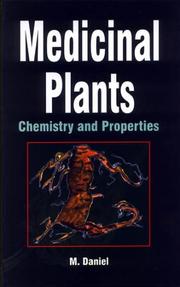
ISBN: 1578083958 Year: 2006 Publisher: Enfield : Science publishers,
Abstract | Keywords | Export | Availability | Bookmark
 Loading...
Loading...Choose an application
- Reference Manager
- EndNote
- RefWorks (Direct export to RefWorks)
MEDICINAL PLANTS --- MEDICINAL PLANTS --- CHEMICAL COMPOSITION --- PROPERTIES --- MEDICINAL PLANTS --- MEDICINAL PLANTS --- CHEMICAL COMPOSITION --- PROPERTIES
Book
ISBN: 0902951165 Year: 2006 Publisher: Herts : Collaborative International Pesticides Analytical Council limited (CIPAC),
Abstract | Keywords | Export | Availability | Bookmark
 Loading...
Loading...Choose an application
- Reference Manager
- EndNote
- RefWorks (Direct export to RefWorks)
pesticides --- pesticides --- chemicophysical properties --- chemicophysical properties --- Chemical composition --- Chemical composition --- Analytical methods --- Analytical methods
Dissertation
Abstract | Keywords | Export | Availability | Bookmark
 Loading...
Loading...Choose an application
- Reference Manager
- EndNote
- RefWorks (Direct export to RefWorks)
Punica granatum --- Punica granatum --- Varieties --- Varieties --- Fruit juices --- Fruit juices --- Extraction --- Extraction --- Chemical composition --- Chemical composition --- Tunisia --- Tunisia
Book
ISBN: 2857942303 Year: 2006 Publisher: Paris : ACTA Publications,
Abstract | Keywords | Export | Availability | Bookmark
 Loading...
Loading...Choose an application
- Reference Manager
- EndNote
- RefWorks (Direct export to RefWorks)
Crops --- Crops --- Weeds --- Weeds --- Herbicides --- Herbicides --- pesticidal properties --- pesticidal properties --- Pesticide selectivity --- Pesticide selectivity --- Pesticide resistance --- Pesticide resistance --- Plant response --- Plant response --- Plant physiology --- Plant physiology --- toxicity --- toxicity --- Chemical composition --- Chemical composition --- evaluation. --- evaluation --- Weed control --- Weed control
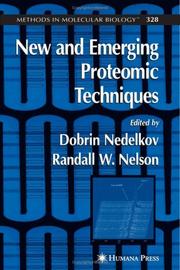
ISBN: 1280832924 9786610832927 159745026X 1588295192 Year: 2006 Publisher: Totowa, NJ : Humana Press : Imprint: Humana,
Abstract | Keywords | Export | Availability | Bookmark
 Loading...
Loading...Choose an application
- Reference Manager
- EndNote
- RefWorks (Direct export to RefWorks)
Numerous emerging technologies have propelled the growth of proteomics into a wide-ranging discipline with great potential to improve human health through the discovery of new protein biomarkers and therapeutics. In New and Emerging Proteomic Techniques, a panel of leading researchers and innovators describe in step-by-step detail the latest techniques that promise to significantly impact the practice of proteomics, as well as its success in developing novel clinical agents. The methods described here span the entire spectrum of top-down and bottom-up approaches, including microarrays, gels, chromatography, and affinity separations, and address every aspect of the human proteome, both quantitatively and qualitatively. The techniques of protein detection utilized are diverse and range from fluorescence and resonance light scattering to surface plasmon resonance and mass spectrometry. Where necessary, two or more distinct techniques are provided for a given problem, and advanced bioinformatics approaches are presented for the analysis of complex proteomic data. The protocols follow the successful Methods in Molecular Biology™ series format, each offering step-by-step laboratory instructions, an introduction outlining the principles behind the technique, lists of the necessary equipment and reagents, and tips on troubleshooting and avoiding known pitfalls. Comprehensive and easy to use, New and Emerging Proteomic Techniques offers expert and novice investigators alike today's most promising proteomics techniques for probing the biological processes and understanding the diseases of the human body.
Biochemistry. --- Biochemistry, general. --- Biological chemistry --- Chemical composition of organisms --- Organisms --- Physiological chemistry --- Biology --- Chemistry --- Medical sciences --- Composition
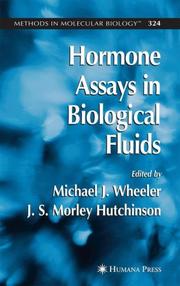
ISBN: 128035867X 9786610358670 1592599869 1588290050 Year: 2006 Publisher: Totowa, NJ : Humana Press : Imprint: Humana,
Abstract | Keywords | Export | Availability | Bookmark
 Loading...
Loading...Choose an application
- Reference Manager
- EndNote
- RefWorks (Direct export to RefWorks)
Although automated systems can measure all common hormones in human blood, they are expensive and often incapable of measuring hormones in urine, saliva, and animals. In Hormone Assays in Biological Fluids, expert researchers who have developed and applied significant new assays describe in step-by-step detail readily reproducible methods for measuring a broad variety of hormones, related peptides, and synthetic steroids in various biological fluids. The hormones measured range from glucocorticoids in biological fluids, urinary steroids, aldosterone in blood, and plasma renin activity, to gut hormones in plasma, melatonin, prolactin, 6-sulfatoxymelatonin, and androgens in blood, saliva, and hair. The emphasis is on noncommercial assays so that investigators can develop novel methods suited to their special needs. Commercial assays are also described for comparative purposes. Tutorials on radioimmunoassay, gas chromatography-mass spectrometry, high-performance liquid chromatography, and polymerase chain reaction techniques help readers choose the best methods for their purpose. The protocols follow the successful Methods in Molecular Medicine™ series format, each offering step-by-step laboratory instructions, an introduction outlining the principles behind the technique, lists of the necessary equipment and reagents, and tips on troubleshooting and avoiding known pitfalls. Wide-ranging and highly practical, Hormone Assays in Biological Fluids illuminates the many different methods available for a broad range of hormone assays, enabling researchers to choose the optimal existing methods or develop novel assays for their specialized purposes.
Biochemistry. --- Biochemistry, general. --- Biological chemistry --- Chemical composition of organisms --- Organisms --- Physiological chemistry --- Biology --- Chemistry --- Medical sciences --- Composition
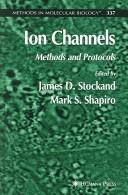
ISBN: 1280832169 9786610832163 1597450952 1588295761 Year: 2006 Publisher: Totowa, NJ : Humana Press : Imprint: Humana,
Abstract | Keywords | Export | Availability | Bookmark
 Loading...
Loading...Choose an application
- Reference Manager
- EndNote
- RefWorks (Direct export to RefWorks)
It is now clear that ion channels play essential roles in cell biology and physiology and that their dysfunction is the root cause of many human diseases. In Ion Channels: Methods and Protocols, internationally recognized biomedical scientists describe recent technological breakthroughs and demonstrate their use in successful experimental designs. The diverse applications range from the study of allosteric regulation of ion channel activity using a classic mutagenesis approach, to the study of channel subunit stoichiometry using a novel biophysical approach based on fluorescence resonance energy transfer. Highlights include methods for heterologous expression of ion channels in cells, for determining channel structure-function, for studying channel regulation and physiological function, and for genetic screening and investigating channelopathies. The protocols follow the successful Methods in Molecular Biology™ series format, each offering step-by-step laboratory instructions, an introduction outlining the principles behind the technique, lists of the necessary equipment and reagents, and tips on troubleshooting and avoiding known pitfalls. Comprehensive and highly practical, Ion Channels: Methods and Protocols offer both novice and experienced researchers a versatile collection of proven techniques for illuminating the structure, function, and regulation of ion channel proteins and finding suitable drug targets when they cause disease.
Biochemistry. --- Biochemistry, general. --- Biological chemistry --- Chemical composition of organisms --- Organisms --- Physiological chemistry --- Biology --- Chemistry --- Medical sciences --- Composition
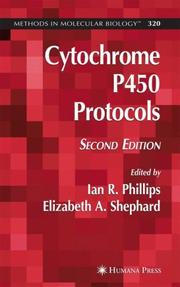
ISBN: 1280358629 9786610358625 1592599982 1588294412 Year: 2006 Publisher: Totowa, NJ : Humana Press : Imprint: Humana,
Abstract | Keywords | Export | Availability | Bookmark
 Loading...
Loading...Choose an application
- Reference Manager
- EndNote
- RefWorks (Direct export to RefWorks)
For this second edition of their much praised Cytochrome P450, the editors have collected accounts of the essential core techniques that use the latest methodologies for the investigation of P450s. Highlights include protocols for spectral analysis and purification of P450s, enzymatic assays of P450s and flavin-containing monooxygenases (FMOs), expression of P450s and FMOs in heterologous systems, and the production and use of antipeptide antibodies. Additional chapters contain readily reproducible techniques for the transfection of hepatocytes for gene regulation studies, P450 reporter gene assays, in situ hybridization, and analysis of genetic polymorphisms. Also described are techniques for the generation of mice with targeted gene disruptions. Although the emphasis is on P450s of mammalian origin, many of the readily reproducible methods described are suitable for P450s from any source. Each chapter is written by researchers who have been involved in the development and application of the particular technique to P450s or FMOs. The protocols are presented in a step-by-step manner, with extensive cross-references to notes that highlight critical steps, potential problems, and alternative methods so that the researcher can understand the basis of the method and perform it successfully. Cutting-edge and highly practical, Cytochrome P450, Second Edition provides both novices and experienced researchers across many fields all the tools needed today to elucidate the crucial biological role played by cytochrome P450 in the metabolism of therapeutic drugs, chemical carcinogens, and environmental pollutants.
Biochemistry. --- Biochemistry, general. --- Biological chemistry --- Chemical composition of organisms --- Organisms --- Physiological chemistry --- Biology --- Chemistry --- Medical sciences --- Composition
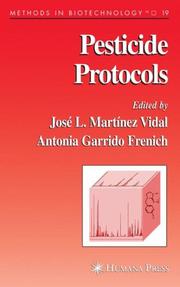
ISBN: 1588294102 9786610358113 1280358114 159259929X Year: 2006 Publisher: Totowa, NJ : Humana Press : Imprint: Humana,
Abstract | Keywords | Export | Availability | Bookmark
 Loading...
Loading...Choose an application
- Reference Manager
- EndNote
- RefWorks (Direct export to RefWorks)
Recent advances in the analysis of pesticide residues in both environmental and food commodities hold out the possibility of analyzing many pesticides in one analytical run. In Pesticide Protocols, expert researchers-who have each perfected the techniques they write about-describe in step-by-step detail robust methods for the detection of pesticide compounds or their metabolites, techniques that are highly useful in food, environmental, and biological monitoring, and in studies of exposure via food, water, air, and the skin or lungs. The methods range from gas and liquid chromatography coupled to mass spectrometry detection and other classic detectors, to capillary electrophoresis and immunochemical or radioimmunoassay techniques. The authors apply these broad-ranging techniques to the analysis of several families of pesticides, to pesticide residues in vegetables, to pesticides in water and air, and to pesticide exposure. The authors have focused on extraction and cleanup procedures in order to develop and optimize more fully automated and miniaturized methods, including solid-phase extraction, solid-phase microextraction, microwave-assisted extraction, and on-line tandem liquid chromatography trace enrichment, among others. The protocols follow the successful Methods in Biotechnology™ series format, each offering step-by-step laboratory instructions, an introduction outlining the principles behind the technique, lists of the necessary equipment and reagents, and tips on troubleshooting and avoiding known pitfalls. Comprehensive and versatile, Pesticide Protocols offers analysts powerful and highly practical tools for analyzing the presence of pesticides in complex matrices.
Biochemistry. --- Biochemistry, general. --- Biological chemistry --- Chemical composition of organisms --- Organisms --- Physiological chemistry --- Biology --- Chemistry --- Medical sciences --- Composition
| Listing 1 - 10 of 175 | << page >> |
Sort by
|

 Search
Search Feedback
Feedback About UniCat
About UniCat  Help
Help News
News